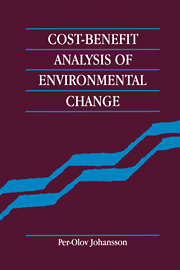Book contents
- Frontmatter
- Contents
- List of figures
- Preface
- 1 Introduction
- 2 Some basic concepts
- 3 Consumer surplus measures
- 4 Valuing public goods: practical methodologies
- 5 General equilibrium cost-benefit rules
- 6 Cost-benefit rules, national income accounts and sustainable development
- 7 Valuation and aggregation: intragenerational and intergenerational issues
- 8 Cost-benefit rules in a risky world
- 9 Valuing changes in access conditions, health risks and information
- 10 Empirical applications
- 11 Policy instruments and international environmental problems
- Notes
- References
- Index
11 - Policy instruments and international environmental problems
Published online by Cambridge University Press: 15 January 2010
- Frontmatter
- Contents
- List of figures
- Preface
- 1 Introduction
- 2 Some basic concepts
- 3 Consumer surplus measures
- 4 Valuing public goods: practical methodologies
- 5 General equilibrium cost-benefit rules
- 6 Cost-benefit rules, national income accounts and sustainable development
- 7 Valuation and aggregation: intragenerational and intergenerational issues
- 8 Cost-benefit rules in a risky world
- 9 Valuing changes in access conditions, health risks and information
- 10 Empirical applications
- 11 Policy instruments and international environmental problems
- Notes
- References
- Index
Summary
Thus far the question of how to achieve a socially reasonable allocation of environmental resources has not been addressed. Nor has the evaluation of activities which harm other countries been considered. This final chapter takes a brief look at both these issues, but the reader interested in details is referred to Barrett (1990), Baumol and Oates (1988), Bohm (1990), Forsund and Strom (1988), Hoel (1992), Holmer and Howe (1991), Nordhaus (1991), Opschoor and Vos (1989), Siebert (1987), Tietenberg (1992) and Weitzman (1974), just to mention a few. In section 11.1 the most commonly used policy instruments (regulations, emission charges and tradeable emission permits) and their properties are discussed. Section 11.2 is devoted to the treatment of a unidirectional externality in a social cost-benefit analysis. The usual example of this kind of externality is an upstream country polluting a river and hence harming downstream countries. The chapter ends with a presentation of a study of sulphur emissions in Europe. The costs and benefits of different strategies for reducing such emissions are presented.
Policy instruments
There are several ways of inducing polluting firms to reduce their emissions. In this section, the three most common are briefly presented. These policy instruments are regulations, emission charges and tradeable emission permits.
Information
- Type
- Chapter
- Information
- Cost-Benefit Analysis of Environmental Change , pp. 200 - 213Publisher: Cambridge University PressPrint publication year: 1993
